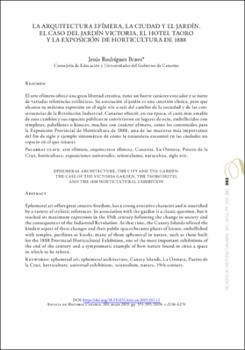La arquitectura efímera, la ciudad y el jardín. El caso del jardín Victoria, el Hotel Taoro y la Exposición de Horticultura de 1888
Autor
Rodríguez Bravo, JesúsFecha
2019Resumen
El arte efímero ofrece una gran libertad creativa, tiene un fuerte carácter evocador y se nutre
de variadas referencias estilísticas. Su asociación al jardín es una cuestión clásica, pero que
alcanza su máxima expresión en el siglo xix a raíz del cambio de la sociedad y de las consecuencias
de la Revolución Industrial. Canarias ofreció, en esa época, el cariz más amable
de esos cambios y sus espacios públicos se convirtieron en lugares de ocio, embellecidos con
templetes, pabellones o kioscos, muchos con carácter efímero, como los construidos para
la Exposición Provincial de Horticultura de 1888, una de las muestras más importantes
del fin de siglo y ejemplo sintomático de cómo la naturaleza encontró en las ciudades un
espacio en el que renacer. Ephemeral art offers great creative freedom, has a strong evocative character and is nourished
by a variety of stylistic references. Its association with the garden is a classic question, but it
reached its maximum expression in the 19th century following the change in society and
the consequences of the Industrial Revolution. At that time, the Canary Islands offered the
kindest aspect of these changes and their public spaces became places of leisure, embellished
with temples, pavilions or kiosks, many of them ephemeral in nature, such as those built
for the 1888 Provincial Horticultural Exhibition, one of the most important exhibitions of
the end of the century and a symptomatic example of how nature found in cities a space
in which to be reborn.





